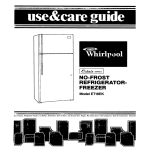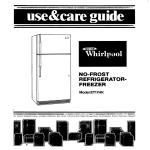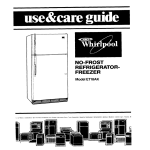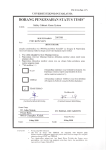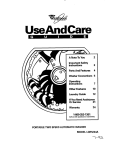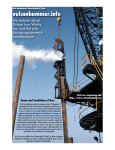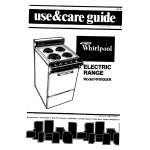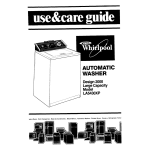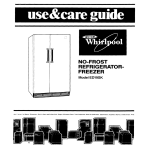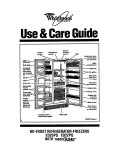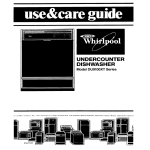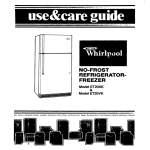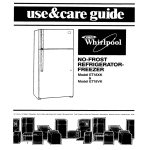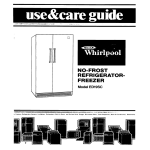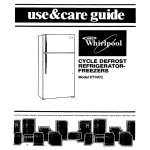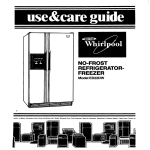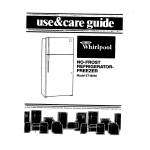Download Whirlpool ET20VM User's Manual
Transcript
NO-FROST REFRIGERATORFREEZER Model ETZOVK & Model ET20VM Please read this Use and Care Guide before you do anything else... This booklet tells you how to start your refrlgemtor, clean lt, move shelves and adjust controls. lf even tells you what new sounds to expect from your refrlgemtor. Treat your new refrigerator wlth care. Use It only to do what home refrigerators are deslgned to do. Parts and features ADJUSTABLE Y FREEZER SHELF I I - UTILITY COMPARTMENT 1 BUTTER COMPARTMENT - ADJUSTABLE GLASS SHELVES BASE GRILLE Copy your Model and Serial Numbers here... When you need service or call with a question, have this information ready: 1. Complete Model and Serial Numbers (from the label located as shown]. 2. Purchase date from sales slip. Copy this information in these spaces. Keep this book, your warranty and sales slip together in a handy place. Please complete and mall the Owner Registmtlon card furnlshed wlth this product. Model Number Serial Number PU,,..h,,se Date Service Company and Telephone Number Contents SAFETYFIRST .......................... BEFOREYOUPLUGITIN ................ Install Properly ...................... Level Refrigerator-Freezer ........... Remove Sales Labels ................ Clean It ............................. Plug Itln ............................. USING YOUR REFRIGERATOR........... Setting the Controls .................. Changing the Control Settings ....... Power Saving Control ................ Adjusting Refrigerator Shelves ....... Removing and Adjusting the Freezer Shelf. .................. Removing the Crispers and Cover ... Page 6 Moving the Meat Pan and Cover. .... 7 Changing the Light Bulbs ............ 7 Removing the Base Grille ............ 7 Ice Cube Trays ...................... 7 Automatic Ice Maker ................ B Sounds You May Hear ............... X Energy Saving Tips .................. CLEANING YOUR REFRIGERATOR ...... 9 Cleaning Chart ..................... 10 FOOD STORAGE GUIDE ................ 10 Storing Fresh Food ................... Freezing and Storing Frozen Foods ... 11 14 VACATION AND MOVING CARE. ....... IF YOU NEEDSERVICE OR ASSISTANCE . 15 16 REFRIGERATORWARRANTY ............ 3 4 4 4 4 4 5 5 5 5 6 6 6 01987 Whirlpool Corporation Before you plug it in Important Before using your refrigerator, you are personally responsible for making sure that it... l is installed and leveled on a floor that will hold the weight, and in an area suitable for its size and use. l is connected only to the right kind of outlet, with the right electrical supply and grounding. (Refer to your “Electrical Requirements and Grounding Instructions:‘) l is used only for jobs expected of home refrigerators. l l l l l l is not near an oven, radiator or other heat source. is properly maintained. is out of the weather. is used in an area where the room temperature will not fall below 55°F (13°C). is not used by those who may not understand how it should be used. is not loaded with food before it has time to get properly cold. Install properly... Remove sales labels... Remove the Consumer Buy Guide label, tape and any lnslde labels before using the refrigerator. To remove any remalnlng glue: 1. Rub briskly with thumb to make a ball then remove. OR 2. Soak area with liquid hand dishwashing detergent before removing glue as described in step 1. DO NOT USE rubblng alcohol or flammable or toxic solvents, such as acetone, gasoline, carbon tetmchlorlde, etc. These can damage the material. NOTE: DO NOT REMOVE ANY PERMANENT INSTRUCTIONS LABELS INSIDE YOUR REFRIGERATOR. Do not remove the Tech sheet fastened under the refrlgemtor at the front. Clean it... 1. Allow YZinch (1.25 cm] space on each side and at the top of the refrigerator for ease of installation. 2. If the refrigerator is to be against a wall, you might want to leave extra space so the door can be opened wider. 3. The refrigerator back can be flush against the wall. Level refrigerator-freezer... All’ USE SCREWDRIVER TO ADJUST Clean your refrigerator before using it. See cleaning instructions on page 8. 1 Plug- it in... 3-PRONG TYPE WA1 FRONT ROLLER VELLING SCREW REFRIGERA;OR POWER CORD 1. Remove base grille (see page 7). 2. To raise front, turn screw in direction shown. 3. To lower front, turn screw in the direction shown, 4. Check with level. 4 3-PitONG GROUNDING PLUG RECOMMENDED GROUNDING METHOD A 115Volt, 60 Hz., AC only 15 or 20 ampere fused and properly grounded electrical supply is required. It is recommended that a separate circuit serving only this appliance be provided. Do not use an extension cord. Use a receptacle which cannot be turned off with a switch or pull chain. See individual electrical requirements and grounding instruction sheet in your literature package. Using your refrigerator REFRIGERATOR’COMROL INDICATOR-LIGHT POWER SAilNG CONTROL LIGHT-SWITCH FREEZER-CONTROL Setting the controls... Controls forthe refrigerator and freezer are in the refrigerator. When the refrigerator is plugged in for To adjust a conhol, reach under the console and turn the knob. Glve the retrlgerator tlme to cool down completely before addlng food. (This may take several hours.) These setilngs should be about tight for normal household refrigerator usage. The controls will be set about right when milk or juice is as cold as you like when ice cream is firm. Refirgerator Control adjustments range from 1 to 8. Freezer Control adjustments range from A to D. Changing the control settings... l If you need to adjust temperatures in refrigerator or freezer, use the settings listed in the chart below. l l Adjust the Refrigerator Control first. Wait at least 24 hours between adjustments. Then adjust the Freezer Control if needed. CONDITION: a_c_x.Ab%~a-s. REASON: sm5m . ‘,.*^Y,Door opened often Large amount of food added Door opened often COOL-LINE@ service assistance telephone number @we 15I. Controls not set correctly for your conditions -is,-“. L “. _n_..az 1“,.,“C. KNOTT If ICE isn’t Heavy ice usage MADE EASTENOUGH Very cold room temperature (can’t cycle ofte __1m C**I-~YME&mY-*.z QOI.---.*-llIf BOTH SECTIONS Door opened often are TOO WARM Large amount of food added Verv warm or very cold room temperatures Section ls TOO COLD Power Saving Control... The Power Savlng Control on the Control Console operates electric heaters around the door openings. These heaters help keep moisture from forming on the outside of the refrigerator. POWER couI”Y~s PtD”Cls LESS EIIIPICQ tNlKG” MOlSWll SAVING CONTROL RECOMMENDED CONTROL SEllINGS: .I-Refrigerator Freezer 6 D Refrigerator 4 2 Refrigerator Freezer A w- ~~Inm->R.~-<___/a 4 Refrigerator A Freezer .~ L_. .- -.I rjr,_ s-mI”v Refr,igerator Freezer 1. Use the “CONSUMES LESSENERGY”setting when humidity is low. 2. Use the “REDUCESEXTERIORMOISTURE”setting if moisture forms on the outside of the refrigerator. The indicator light will glow when the switch is in the “REDUCESEXTERIORMOISTURE” position. 5 Adjusting the refrigerator shelves... Shelves can be adjusted to match the way you use your refrigerator. Glass shelves are strong enough to hold botttes, milk and other heavy food items. To remove glass shelves: 1. Tilt up at front. 2. Lift up at back. 3. Pull shelf straight out. To replace glass shelves: 1. Guide the rear hooks inio the slots in the shelf supports. 2. Tilt up front of shelf until hooks drop into slot. Lower front of shelf to level position. Removing and adjusting the freezer shelf... To remove the shelf: 1. Lift front slightly. 2. Lift back off supports. 3. Replace in reverse order. To adjust the shelf: 1. Remove shelf. 2. Remove supports by sliding upwards. 3. Replace supports on desired level. 4. Replace shelf. SHELFSUPPORT Removing crispers and crisper cover... PULL OUT 10 STOP, LIFT THE FRONT AND PULL AGAIN To remove the crispers: 1. Slide crisper straight out to stop, liff front, then slide the rest of the way out. 2. Replace in the reverse order. To remove the cover: 1. Push up glass insert from bottom, then slide out with both hands. 2. Lift front of cover frame. 3. Lift out cover frame by pulling up and out. 4. Remove metal cover support. To replace the cover: 1. Replace metal cover support on wall supports in front section of cabinet. 2. Fit back of corner into notch supports on walls of refrigerator, then lower into place. 3. Slide back of glass insert into place, then lower front. REMOVE THE LIFT THEFRAME THENTHEBACK GLASS IS HEAVY. BE CAREFUL. Moving the meat pan and cover... PULL OUT TO STOP. LIFT THE FRONT AND PULL AGAIN. AVY. To remove the meat pan: 1. Slide the meat pan out to stop. 2. Lift the front. %3.Slide the pan the rest of the way out. 4. Replace in reverse order. To remove the cover: 1. Tilt front of cover up, lift at back, and pull straight 0U-t. 2. Replace in reverse order. 6 Changing the light bulbs... 3. Replace with a 40-watt appliance Removing the base grille... r To remove the grille: 1. Open the doors. 2. Pull grille outwards as shown. 3. Do not remove Tech sheet fastened orille Ice cube trays... To remove Ice: 1. Hold tray at both ends. 2. Slightly twist. (Model ETPOGK) If cubes are not used, they may shrink. The moving cold air starts a slow evaporation. The longer cubes are stored, the smaller they get. If you have Model ET20VM and have the automatic ice maker accessory, or if you have Model ET20VK and plan to add one later (Part No. ECKMF-831,there are a few things you will want to know: l The ON/OFF lever is a wire signal arm. Downfor making ice automatically Up...to shut off the ice maker. l Shake the bin occasionally to keep cubes separated, and to obtain increased storage capacity. l It is normal for ice crescents to be attached by a corner. They will break apart easily l l l l l l l You will hear water running when ice maker is working. You’ll hear ice fall into the bin. Don’t let these sounds bother you. SUPPORT TABS To replace the grille: 1. Line up grille support tabs with metal clips. 2. Push firmly to snap into place. 3. Close the doors. behind Automatic ice maker.. . METAL CLIPS SUPPORT TABS - . bulb. The ice maker will not operate until the freezer is cold enough to make ice. This can take overnight. Because of new plumbing connections, the first ice may be discolored or off-flavored. Discard the first few batches of ice. If ice is not being made fast enough and more ice is needed, turn the Refrigerator Control toward a higher number. Wait a day and, if necessary, turn the Freezer Control toward A. If you remove the ice bin, raise the signal arm to shut off the ice maker. When you return the bin, push it all the way in and lower the arm to the ON position. If cubes are stored too long, they may develop an off-flavor...like stale water. Throw them away They will be replaced. Cubes in the ice bin can also become smaller by evaporation. Good water quality is important for good ice quality It is not recommended that the ice maker be connected to a softened water supply. Water softener chemicals such as salt from a malfunctioning softener can damage the ice maker mold and lead to poor quality ice. If a softened water supply cannot be avoided, then it is important that the water softener be well maintained and operating properly. 7 Sounds you may hear... ‘/ =l P 3 ’ + Possible Sounds: Slight Hum, Sof? HG 0 CiM;sg or Snapplng : l .a-. Water Sounds: Your new refrigerator may make sounds that your old one didn’t. Because the sounds are new to you, you might be concerned about them. Don’t be. Most of the new sounds are normal. Hard surfaces like the floor, walls and cabinets can make the sounds seem louder. The following chart describes the kinds of sounds that might be new to you, and what may be making them. Probable Causes: -___I You may hear the refrigerator’s fan motor and moving air. The thermostat makes a definite click when the refrigerator stops running. It also makes a sound when the refrigerator starts. The defrost timer will click when the defrost cycle starts and stops. When the refrigerator stops running, you may hear gurgling in the tubing for a few minutes after it stops. You may also hear defrost water running into the defrost water pan. -l Ice Maker Sounds: If your refrigerator has an ice maker, you may hear buzzing (from the water valve), trickling water and the clatter of ice dumped - trlckllng water into the bin. - thud (clatter of Ice) Your refrigerator has a high-efficiency compressor and motor. l Runnlng Sounds: It will run longer than older designs. It may even seem to run most of the time. s--i.*.* --~xa+‘.~~y.I~L -1m-.-m”-w+.a- l ’ Energy saving tips... You can help your refrigerator use less electricity Check door gaskets for a tight seal. Level the cabinet to be sure of a good seal. l Clean the condenser coil regularly. l Open the door as few times as possible. Think about what you need before you open the door. Get everything out at one time. Keep foods organized so you won’t have to search for what you want. Close door as soon as food is removed. l Go ahead and fill up the refrigerator, but don’t overcrowd it so air movement is blocked. l l Cleaning your refrigerator Both the refrigerator and freezer sections defrost automatically. But both should be cleaned about once a month to help prevent odors from building up.Ofcourse,spillsshould bewipeduprightaway. To clean your refrigerator turn the Refrigerator Control to OFF,unplug it, take out all removable parts and clean it according to the following directions. l l It is a waste of electricity to set the refrigerator and freezer to temperatures colder than they need to be. If ice cream is firm in the freezer and drlnks are as cold as your family likes them, that’s cold enough. Keep the Power Saving Control on CONSUMES LESSENERGYunless moisture forms on refrigerator exterior. Make sure your refrigerator is not next to a heat source such as a range, water heater, furnace, radiator or in direct sunlight. Cleaning chart... .-eePart b-.-.*.-- -r.,-dyea.id .._l,j _r .. =, , -_: .--.j*-N_l .I.*v_i-~p.3y~-p‘~ -___1_,-- How to clean What to use -IUrn I-,_qe_~~-~~.c~..--YmT-...~ l Wash removable parts with warm water Sponge or cloth; mild and a mild detergent. detergent and warm water. l Rinse and dry. Removable parts w (shelves, crisper, meat pan, ice cube trays or ice bin, etc.) _r_l u_o___-, urn.> C-..r-W?.$.-- ,.l.xcIwR__ImF*_-.rL* l Wash with warm water and a mild Sponge, cloth or paper Outside detergent. Do not use abmrlve or harsh towel; mild detergent; appliance wax (or cleansers. good auto paste wax]. l Rinse and dry. l Wax painted metal surfaces at least twice a year with appliance wax or a good auto paste wax. Apply wax with a clean, soff cloth. Do not use wax on plastic parts. Waxlng palnted metal surfaces provldes rust protection. l Wash with warm water and Sponge, soft cloth or Inside walls (Freezer paper towel, baking should be allowed to - mild detergent or soda, warm water, mild warm up so cloth won’t - baking soda (2 tabtespoons [26 g] to detergent. stick.] 1 quart [.95 L.] warm water). l Rinse and dry. -.m”-m-.Cb%xvI-ILIU_I--*~(NI_-(J--~II-lj--i..l Wash with mild detergent and warm Sponge, soft cloth 07 Door liners and gaskets paper towel; mild water. detergent, warm water. l Rinse and dry. DO NOT USE Cleanlng waxes, concentrated detergents, bleaches or cleansers oontalnlng petroleum on plastic pa*. ~Y-_~-.YBmal.l”r*..I-.I-,IC.RC.l Wash with a soff cloth or sponge. Mild detergent and Dark plastics warm water; soft clean (covers and panels) l Rinse and dry. sponge and soft, clean cloth. DO NOT USE paper towels, wlndow sprays, scouring cleansers, or flammable or toxic solvents llke acetone, gasoline, carbon tetrachlorlde, etc. These can scratch or damage the matertal. -m-sT-I-..PC_ICi*~,1-1YY31.V-9(1 -*a-u Sponge or cloth; mild l Remove base grille. (See page 8.) Defrost pan detergent and warm l To remove defrost pan, liff pan over wire water. brace (remove tape; if any). l Wash defrost pan with warm water and mild detergent. l Rinse and dry. l Replace with notched corner to the rear. Push it all the way in. l Make sure defrost drain tube is pointing into pan. Remove base grille. Clean dust and lint from condenser at least every other month. l Replace base grille. -w--1am1-.--16.ss.m-m _~~-w.--l-wL~~ l Roll refrigerator out only as far as water Usual floor cleaners. Floor under refrigerator supply line allows. l Clean the floor. l Roll refrigerator back. l Check to see if the refrigerator is level. _,_/ *.j. _.- .. i/-- _. ,r,,> . v,.*,L^_.,-.,....._3yi~ila-r.,,.q,I,.. r IT.<--..?.- Condenser Coil Vacuum cleaner; using the extended narrow attachment. l l Food storage guide STORING FRESH FOOD Cured or Smoked Meat and Cold Cuts. Ham, bacon, sausage, cold cuts, etc., keep best in original wrappings. Once opened, tightly re-wrap in plastic wrap or aluminum foil. Canned Ham. Store in refrigerator unless the label says it’s okay to store on the shelf. Do not freeze. Fresh Poultry...Wrap in plastic wrap. The plastic on poultry, as purchased, may be used for storage. STORAGECHART FOR FRESHAND CURED MEAT’ There is a right way to package and store refrigerated or frozen foods. To keep foods fresher, longer, take the time to study these recommended steps. Leafy Vegetables...Remove store wrapping and trim or tear off bruised and discolored areas. Wash in cold water and drain. Place in plastic bag or plastic container and store in crisper. Cold, moist air helps keep leafy vegetables fresh and crisp. Vegetables with Skins (carrots, peppers)...Store in crisper, plastic bags or plastic container. Fruit...Wash, let dry and store in refrigerator in plastic bags or crisper. Do not wash or hull berries until they are ready to use. Sort and keep berries in their store container in a crisper, or store in a loosely closed paper bag on a refrigerator shelf. Meat*...Meat is perishable and expensive...you won’t want to waste an ounce of it through careless handling. The following list and chart give you packaging hints and time limits. Store meat in the meat pan. Fresh, prepackaged Meat. Store fresh meat in the store wrapping. Vacuum packaged meat can be frozen for as long as one month if the seal is not broken. If you want to keep it frozen longer, you should wrap it with special freezer wrapping material. Fresh Meat, Not Prepackaged. Remove the market wrapping paperand re-wrap in aluminum foil for storing it unfrozen. Cooked Meat. Wrap or cover cooked meat with plastic wrap or aluminum foil. Store immediately. 10 I ww ..................... VaMyMeds.. Chlcken ...... . ..................... ........................ GroundBeef ....... . .......... Sfeakrandbasts ...................... curedMeafs.. Bacon .... . ......................... cold CUR ........................... lto2 3t05 7tolO St07 3to5 ‘If meat Is to be stored longer than the times given, follow ihe difectlons for freezlng. NOTE: Fresh fish and shellfish same day as purchased. should be used the Eggs...Store without washing in the original carton or use the egg containers in the Utility Compartment in the door of your refrigerator. Milk...Wipe milk cartons. For best storage, place milk on interior shelf. Beverages...Wipe bottles and cans. Store on a door shelf or inside the refrigerator. Butter...Keep opened butter in covered dish or in the Utility Compartment. When storing an extra supply, wrap in freezer packaging and freeze. Cheese...Store in the original wrapping until you are ready to use it. Once opened, re-wrap tightly in plastic wrap or aluminum foil. Condiments...Store small jars and bottles (catsup, mustard, jelly, olives] on the door shelves where they are in easy reach. Leftovers...Cover leftovers with plastic wrap or aluminum foil to keep food from drying out and transferring food odors. Plastic containers with tight lids are fine, too. FREEZING & STORING FROZEN FOODS The freezer section is designed for storage of commercially frozen foods and for freezing foods at home. Packaging - The secret of successful freezing is in the packaging. The wrap you use must be air, moisture and vapor proof. The way you close and seal the package must not allow air, moisture or vapor in or out. Packaging done in any other way could cause food odor and taste transfer throughout the refrigerator and drying of frozen food. Rigid polyethylene (plastic) containers with tightfitting lids, straight-sided canning/freezing jars, heavy-duty aluminum foil, plastic-coated paper and nonpermeable plastic wraps (made from a Saran film) are recommended. NOTE: Heatsealed boiling bags are easy to use and can be used by themselves or as carton liners. Sealing-When sealing foods in bags squeeze out the air [liquids need headspace to allow for expansion). Twist the top and turn it back. fasten tie securely around the doubled-over tail. Put the label inside transparent bags; use self-adhesive label on outside of opaque ones. Air-tight wrapping calls for “drugstore” wrap. Cut the sheet about one-third longer than the distance around the food. Bring the ends together and fold in [toward the food] at least twice to seal out air. Creaseendsclosetofood,pressairfrom package. Fold tips over twice. Finish package and tape closed. NOTE: With unboned meats, pad sharp edges with extra wrap or use stockinette to protect the wrap from punctures. DO NOT USE: Bread wrappers l Non-polyethylene plastic containers l Containers without tight lids l Waxed paper l Waxed-coated freezer wrap l Thin, semi-permeable wrap None of these are totally moisture, air or vapor proof. The use of these wrappings could cause food odor and taste transfer and drying of frozen food. l Freezing Fruits - Select ripe, blemish-free fruits. Be sure they taste as good as they look. Wash 2 to 3 quarts [liters] at a time and drain. Fruitthatstands in water may lose food value and become soggy. Sort, peel, trim, pit and slice as needed. Pack in rigid wide-mouthed containers or other recommended material. Leave head space to allow liquids to expand during freezing. 1' Freezlng Vegetables - Freeze only fresh highquality vegetables picked when barely mature. For best results, freeze no more than 2 to 3 hours after picking. Wash in cold water, sort and cut into appropriate sizes. Blanch or scald. Pack in recommended container and freeze. Do not freeze lettuce, celery, carrot sticks, potatoes or fresh tomatoes. All will become limp or mushy, Tomatoes will collapse when thawed. Freezing Cooked Food-Prepare cooked foods as you would for the table; shorten cooking time 10 to 15 minutes to allow for additional cooking during reheating. Omit seasonings and part of the liquid. Plan to add them at reheating time. Potatoes should also be added to soup and stew at heating time. Add crumb and cheese toppings at heating time. Cool as rapidly as possible and freeze at once. Liquid or semi-liquid dishes may be frozen in recommended containers with head-space. Casseroles and other more solid foods may be frozen in the baking container. If you don’t want to leave your casserole dish in the freezer, line it with foil. Bake, cool, freeze, lift out the foil package, bag it and return to freezer. Freezlng Meats - The meat you thaw can only be as good as the meat you freeze. “Drugstore” wrap in meal-size packages. Flat cuts or patties should be wrapped individually or in layers separated by a double thickness of freezer wrap. Make sure store wrappings are moisture and vapor proof. If not, rewrap meats with one of the wraps recommended under “Packaging:’ Freezing Baked Goods- Wrap baked breads in recommended material. Thaw in wrapping. Unbaked yeast breads can be frozen after the first rising. Punch down, wrap and freeze. Bake cookies as usual. Cool and freeze on trays, then pack in recommended freezer bags or cartons. Unbaked cookies may be dropped, molded or rolled and frozen on cookie trays. Store in bag or carton; bake without thawing. Refrigerator-type cookies can be wrapped and frozen in roll form. Thaw only enough to slice when ready to bake. Fruit pies are best frozen unbaked. Bake without thawing. Bake pecan and similar pies before freezing...rich fillings do not freeze solid. Cut steam vents in top crusts when ready to bake. 12 IMPORTANT: Do not expect your freezer to quickof food. Put no more freeze any large quantify unfrozen food into the freezer than will freeze wlfhln 24 hours. (No more than 2 to 3 pounds of food per cubic foot of freezer space.) leave enough space for air to circulate around packages. Be careful to leave enough room at the front so the door can close tightly. FOOD STORAGECHART Storage times* will vary according to the quality of the food, the type of packaging or wrap used (moisture and vapor-proof), and the storage temperature which should be 0°F ( -17.8%). Food Storage Tlme FRUITS Fruit juice concentrate ........ 12 months Commercially frozen fruit ...... 12 months Citrus fruit and Juices ....... 4 to 6 months Others .................... 8to 12months VEGETABLES Commercially frozen ........... 8 months Home frozen .............. 8 to 12 months MEAT Bacon .................... 4weeksorless Corned beef .............. 4 weeks or less (Salting meat shortens freezer Ilfe) Frankfurters ..................... 1 month Ground beef, lamb, veal .... 2 to 3 months Roasts: Beef .................... 6to12months lamb and veal ........... 6 to 9 months Pork ...................... 4to8monfhs Sausage, fresh ............. 1 to 2 months Steaks and chops: Beef .................... 8 to 12 months lamb, veal, pork ......... 3 to 4 months FISH Cod, flounder, haddock sole .......................... 6months Blue fish, salmon ........... 2 to 3 months Mackerel, perch ............ 2 to 3 months Breaded flsh (purchased) ...... 3 months Clams, oysters, cooked fish, crab, scallops ....... 3 to 4 months Alaskan king cmb ............ IO months Shftmp, uncooked ............. 12 months POULTRY Whole ohlcken or turkey ....... 12 months Duck ........................... 6 months Giblets ..................... 2 to 3 months Cooked poultry w/gmvy ....... 6 months Slices (no gravy) ................ 1 month MAIN DISHES Stews; meat, poultry and fish casserole ........ 2 to 3 months TV dinners .................. 3 to 6 months Food Stomge Tlme DAIRY PRODUCTS 6 to 9 months Butter ...................... 12 months Margarlne ..................... Cheese: Camemberf, Mozzarella, 3 months farmer’s .................... Creamed cottage ...... DO NOT FREEZE Cheddar, Edam, Gouda, 6 to 8 weeks Swiss, brick, etc. ........ Freetlng can change texture of cheese. Ice cream, Ice milk, sherbet ..... 2 months EGGS 12 months Whole (mlxed) ................. 12 months Whites ......................... Yolks ........................... 12 months [Add sugar or salt to yolks or whole mixed eggs) BAKED GOODS 3 months Yeast breads and rolls .......... 3 months Baked Brown ‘N Serve rolls ...... 1 month Unbaked breads ................ 2 to 3 months Quick breads .............. 2 to 4 months Cakes, unfrosted ........... 8 to 12 months Cakeqfrosted ............ 12 months Fruit cakes .................... 3 months Cookle dough .................. 8 to 12 months Baked cookies ............ 1 to 2 months Baked ples ................. 4 to 6 months Ple dough only ............. *Based on U.S.D.A.and Mlchlgan Cooperative Extenslon Service suggested storage times. If electricity goes off Call the power company. Ask how long powe will be off. 1. If service is to be interrupted 24 hours or les: keep both doors closed. This will help froze1 foods to stay frozen. 2. If service is to be interrupted longer than 2, hours: (a] Remove all frozen food and store in ( frozen food locker. Or... (b) Place 2 Ibs (0.9 kg] of dry ice in freezer fc every cu. ft of freezer space. This will keel frozen foods for 2 to 4 days. Wear gloves tc protect your hands from dry ice burns. [c] If neither food locker storage nor dry ice i available, use or can perishable food c once. 3. A full freezerwill stay cold longerthana part11 filled one. A freezer full of meat will stay cok longer than a freezer full of baked goods. food contains ice crystals, it may be safe11 refrozen, although the quality and flavor ma1 be affected. Use refrozen foods quickly. If tht condition of the food is poor or you have an! suspicions, it is wise to dispose of it. Care Short vacations... Moving... No need to shut off the refrigerator if you will be away for less than four weeks. Use up perishables: freeze other items. If your refrigerator is equipped with an automatic ice maker: 1. Turn if off. 2. Shut off the wafer supply to the ice maker. 3. Empty the ice bin. If your refrigerator is equipped with an aufomafic ice maker, shut off the ice maker wafer supply a day ahead of time. Disconnect the wafer line. After the last supply of ice drops, lift the signal arm to turn off the ice maker. Remove all food. Pack frozen foods in dry ice. Unplug the refrigerator and clean if thoroughly. Remove everything that comes out. Wrap all parts well and tape them together so they don’t shift and rattle. Screw in the levelling rollers; tape the doors shut; tape the electric cord to the cabinet. When you get to your new home, put everything back, and refer to page 4. Don’t forget to reconnect the wafer supply line if you have an ice maker. Long vacations... Remove all the food if you are going for a month or more. If your refrigerator is equipped with an automatic ice maker, turn off the wafer supply to the ice maker at least a day ahead. When the last load of ice drops, turn off the ice maker. Unplug the refrigerator and clean it...rinse well and dry. Tape rubber or wood blocks to both doors...keeping them open far enough for air to get in. This will keep odor and mold from building UP. To restart refrigerator, erator!’ 14 see “Using Your Refrig- Questions? ...call your CCCL-LINE@ service assistance telephone number Owe 151. If you need service or assistance, we suggest you follow these five steps: L Before calling for assistance... 2. If you need assistance%. Performance problems often result from little things you can find and fix yourself without tools of any kind. Call Whlrlpool phone number. If your refrlgemtor will not operate: Is the electric cord plugged into a live circuit with proper voltage? (See page 4.) l Have you checked your home’s main fuses or circuit breaker box? l Is the Refrigerator Control ON? l If there Is a mttllng or Jlngllng nolse or untamlllar sounds: l Is something on top or behind the refrigerator making noise when the refrigerator is running? l New features on your new refrigerator make new sounds. You may be hearing air flowing from the fans, tlmer clicks for the defrosting cycle, or defrost water draining in the defrost pan. It your Ice maker will not operate: Has the freezer had enough time to get cold? With a new refrigerator, this might take overnight. l Is the signal arm ON...in the down position? l Is the water valve turned on? Is water getting to the ice maker? l CCCL-LINE@ servlce asslstanoe teleDlal tree from anywhere In the U.S.: ~-BOQ-253-~3Q~ and talk with one of our trained Consultants. The Consultants can instruct you in how to obtain satisfactory operation from your appliance or, if service is necessary, recommend a quallfied service company in your area. 3. Whirlpool has a nationwide network of franchised TECH-CARE@ service companies. TECH-CARE service technicians are trained to fulfill the product warranty and provide afterwarrantY service, anywhere in the United States. To locate TECH-CARE service in your area, call our COOLLINE service assistance telephone number [see Step 2) or look in yourtelephone directory Yellow Pages under: IPPLIANCES-HOUSEHOLDMAJOR-SERVICE If a bulb Is burned out: l See instructions for changing light bulbs on page 7. Only use appliance bulbs. If the motor seems to run too much: Is the condenser, behind the refrigerator, free of dust and lint9 l On hot days, or if the room is warm, the motor naturally runs longer. l If the door has been opened a lot, or if a large amount of food has been put in, the motor will run longer to cool down the interior. l Remember: Motor running time depends on different things; number of door openings, amount of food stored, temperature of the room, setting of the controls. And, your new refrigerator may be larger than your old one so it has more space to be cooled. It also has a regular freezer instead of a frozen food compartment. All this means better refrigeration and may require more running time than your old one. A REPAIR ELECTRICAL APPLIANCES UAJGR-REPAIRING b PARTS OR WHIRLPOOL APPLIANCES FRANCHISED TEWCARE SERVICE It there Is water In the defrost pan: 9 This is normal in hot, muggy weather. The pan can even be half full. Make sure the refrigerator is level so the pan does not overflow. It the lights are not worklng: 9 Have you checked your home’s main fuses or circuit breaker box? l Is the power supply cord plugged into a live circuit with the proper voltage? [See page 4.) If you need service?.. WHIRLPOOL WPLIANCES FRANCHISE0 TECH-CARE SERYICE WASHING MAC”lNES. DRIERS L IRONERS-SERVICING WHlRLPOOLAPPLlANCES FRANCHISE0 TECH-CARE SERWCE .SEH\IC'E XYLSLRVlCECO 123MAPLE c '~,M,'A‘VIl-LV 993 9999 4. If you have a problem?.. Call our COOL-LINE service assistance telephone number [see Step 2) and talk with one of our COnsUltants, or if you prefer, write to: Mr. Robert Stanley Division Vice President Whirlpool Corporation 2000 US-33, North Benton Harbor, Ml 49022 5. If you need FSP” replacement parts?.. FSP@is a registered trademark of Whirlpool Corporation for quality parts. Look for this symbol of quality whenever you need a replacement part for your Whirlpool appliance. FSP replacement parts will fit right and work right, because they are made to the same exacting specifications used to build every new Whirlpool appliance. To locate FSP replacement parts in your area, refer to Step 3 above or call the Whirlpool COOL-LINE service assistance number in Step 2. ‘If you must call or write, please provide: model number, serial number, date of purchase, and a complete description of the problem. This information is needed in order to better respond to your request for assistance. I WHIRLPOOL REFRIGERATOR WmANTY LENGTH OF WARRANTY WHIRLPOOL FULL ONE-YEAR WARRANTY From Date of Purchase FSP replacement correct defects FULL FIVE-YEAR WARRANTY From Date of Purchase FSP replacement parts and repair labor to correct defects in materials or workmanship in the sealed refrigeration system. These parts are: t Compressor 2. Evaporator 3. Condenser 4. Drier 5. Connecting tubing WHIRLPOOL WILL PAY FOR parts and in materials repair labor to or workmanship. WILL NOT PAY FOR A. Service calls to: 1. Correct the installation of the refrigerator. 2. Instruct you how to use the refrigerator. 3. Replace house fuses or correct house wiring or plumbing. 4. Replace light bulbs. 6. Repairs when refrigerator is used in other than normal, single-family household use. C. Pick- up and deliver This product is deslgned to be repaired in the home. D. Damage to refrigerator caused by accident, misuse, fire, flood, acts of God or use of products not approved by Whirlpool. E. Any food loss due to product failure. Service under the full warranties must be provided by a franchised TECH-CARE@ service company.’ WHIRLPOOL CORPORATION SHALL NOT BE LIABLE FOR INCIDENTAL OR CONSEQUENTIAL DAMAGES. Some states do not allow the exclusion or limitation of incidental or consequential damages so this limltation or exclusion may not apply to you. This warranty gives you specific legal rights, and you may also have other rights which vary from state to state. Outside the United States, a different warranty may apply. For details, please contact your franchised Whirlpool distributor or military exchange. Part No. 1114045 01987 Whirlpool Corporation Printed in U.S.A.
















